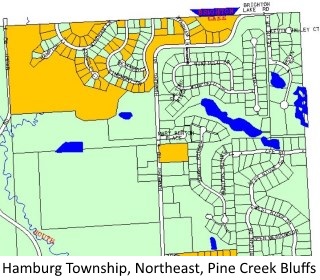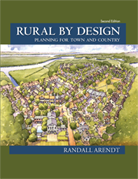
Despite being Livingston County's most populous Township, the Planners and Developers of our northwestern neighbor, Hamburg Township, have in the past twenty years preserved as open space over 2,000 acres. Today's buzzword? Conservation Subdivision.
The idea was Randall Arendt's, so I'll let him explain:
'Subdivision regulations are one of the principal tools forshaping our communities. It is through the subdivision review process that communities most directly assure that residential development is designed in a way which promotes community objectives such as the preservation of open space and natural areas.But to back up a step, why should we be concerned about protecting open space? In a nutshell, by preserving open space we protect streams and water quality, provide habitat for plants and animals, preserve rural “atmosphere,” provide recreational areas, protect home values, and reduce costs of municipal services. In short, land conservation makes our communities better places to live.
As you will see on the following pages, the conservation subdivision approach involves small, but significant, changes to the subdivision design and review process. When integrated with comprehensive plan and zoning provisions which encourage the preservation of open space, a community can — over a period of years — protect an interconnected network of conservation lands. Developers can easily become the community’s leading conservationists, as each new subdivision adds another link to an area-wide open space system. One Michigan community [Hamburg Township] has, in fact, conserved more than 1,000 acres through this approach in the last eight years, a conservation value of at least $10 million. [editor's note: It was 1,000 acres at the time of Arendt's 1999 article. Now the figure is over 2,000 acres.]
It is critical to realize that conservation subdivision design is not only fair to developers, it actually enhances the valueof development. Studies comparing developments built according to conservation design principles with those following more conventional, land consumptive, layouts show that houses tend to sell faster and real estate values appreciate more with conservation design. This should not be surprising. Homebuyer surveys show that people strongly desire open space, recreation areas, and scenic views.Conservation subdivision design differs in several significant ways from the more familiar “cluster development” approach. Under conservation design principles, full density is achievable only when at least 50 percent of potentially buildable land is set aside. This compares with cluster provisions that frequently require only 25 to 30 percent of the gross land area to be conserved. Moreover, with cluster development this open space is often comprised of left over, undesirable areas such as stormwater management facilities or land under high-tension power lines.Although clustering has produced a few small “green islands” here and there, conservation design can protect blocks and corridors of permanent open space. These areas should be pre-identified on a community-wide map of potential conservation lands in the comprehensive plan so that each new development will add to — rather than subtract from — the community’s open space acreage. Another result is that conservation subdivisions make it easier for municipalities to implement community-wide greenway plans, which may depend on developers to provide critical links along particular stream valleys or hilltop ridges.'
LandChoices.org - Conservation Subdivisions in depth, Kirt Manecke
Video:
Randall Arendt: Conservation subdivisions
Tryon Farm, Michigan City, Indiana, an Ed Noonan, Randall Arendt inspired development
(the Tryon Farm website)
Natural Landscaping: Save our environment, preserve water, and wildlife, and save money.
Can landscape architecture preserve our environment? Randall Arendt with Collen Murphy
What is a land trust or land conservancy?
Protect your land with a conservation easement. Part 1: Intro - Tom Bailey, Little Traverse Conservancy
How to preserve land and reduce estate taxes: Conservation easements
Why I started LandChoices: To inform and inspire landowners and planners to preserve land - Kirt Manecke of LandChoices.org
An overview of Conservation Easement Agreements by Robert Orland

 Rural by Design, 2nd ed
Rural by Design, 2nd ed